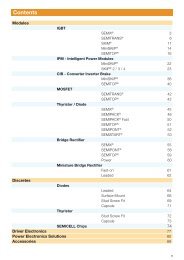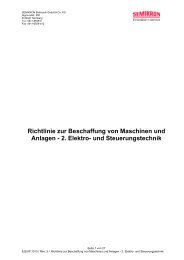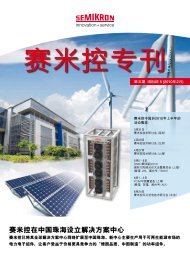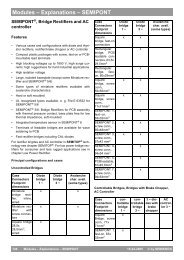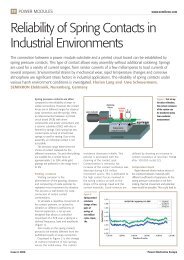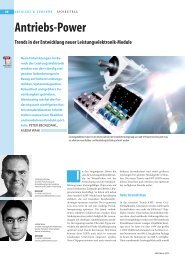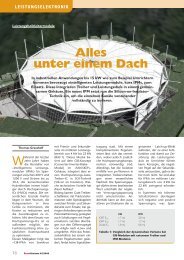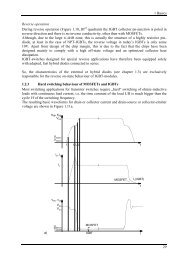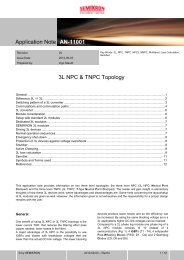Always one step ahead - Semikron
Always one step ahead - Semikron
Always one step ahead - Semikron
Create successful ePaper yourself
Turn your PDF publications into a flip-book with our unique Google optimized e-Paper software.
MiniSKIIP module - first integrated IGBT power<br />
inverter module in solder-free spring contact<br />
technology<br />
51<br />
interface enables differentiated error analysis.<br />
These modules also feature an intelliOff function<br />
for optimum turn-off based on three adjustable<br />
resistances.<br />
Systems for wind and solar power<br />
The significance of a systems and integration<br />
approach is particularly important for wind<br />
power applications. The manufacturers of WPUs<br />
do not come from the electronics sector and<br />
therefore need finished systems that meet their<br />
demands. This is where <strong>Semikron</strong> comes in,<br />
offering suitable stacks featuring power<br />
electronics, driver and heat sink in <strong>one</strong> system.<br />
The same applies to solar power systems<br />
manufacturers whose key competence is not<br />
electronics either. Here, <strong>Semikron</strong> makes a<br />
distinction between low-power solutions up to 5<br />
kW for use in private applications and centralised<br />
inverters for large solar parks with outputs of up<br />
to 500 kW - a figure which is on the rise. At the<br />
moment, 3-level and multi-level inverters are in<br />
particularly high demand for solar applications.<br />
These inverters, originally used in UPS systems,<br />
provide a better approximation of the desired<br />
sinusoidal wave. A further merit of multi-level<br />
inverters is that they offer three voltage states,<br />
while in other modules ON and OFF are the only<br />
possible voltage states. In solar applications,<br />
where efficiency is crucial, the energy has to be<br />
fed into the grid with minimum losses. 3-level<br />
inverters enable higher voltages and<br />
correspondingly lower currents. In comparison<br />
to 2-switch topologies, this brings about a 1.5 -<br />
2% increase in efficiency.<br />
In general,<br />
renewable energies<br />
pose entirely new<br />
problems for<br />
electricity<br />
companies and<br />
consequently for<br />
power electronic<br />
systems, too. Besides<br />
the previous topdown<br />
infrastructure<br />
from the power plant<br />
Andreas Winterholler, to the consumer, we<br />
Product Manager<br />
now have a situation<br />
SEMIKRON<br />
International<br />
where power is being<br />
fed into different<br />
grids from various power generation systems. In<br />
addition to dynamic consumption, we are now<br />
suddenly faced with dynamic grid feed, too.<br />
These fluctuations have to be offset by grid<br />
operators -- a huge challenge for power electronic<br />
systems.<br />
E-mobility<br />
A further new challenge is e-mobility. But here,<br />
too, <strong>Semikron</strong> boasts a wealth of experience: in<br />
the 1990s power electronics were used for the<br />
first ever hybrid vehicles; for almost 20 years<br />
<strong>Semikron</strong> has been <strong>one</strong> of the main suppliers of<br />
technology for forklift equipment. The takeover<br />
of Compact Dynamics opens up possibilities for<br />
the electronics industry at large on <strong>one</strong> of the<br />
most viable future markets. This takeover has<br />
brought about innovative technologies used in<br />
race cars which are to be implemented in<br />
conventional vehicles in the future. In the<br />
E & E 08.2010



